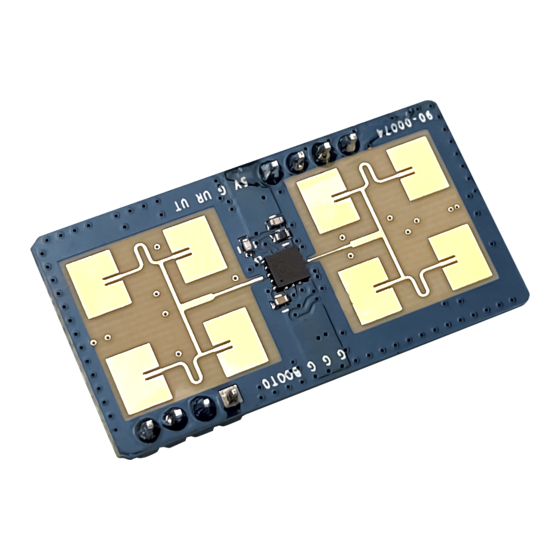
Advertisement
Human Presence Detection Radar HLK-LD1125H-24G
Application Manual
Due to product upgrades or other reasons, the content of this
document will be updated from time to time. This document is
intended as a guide only, and neither the information nor the
recommendations stated shall constitute any express or implied
warranty.
V1.2
2021-9-16
Advertisement

Subscribe to Our Youtube Channel
Summary of Contents for Hi-Link HLK-LD1125H-24G
- Page 1 Human Presence Detection Radar HLK-LD1125H-24G Application Manual Due to product upgrades or other reasons, the content of this document will be updated from time to time. This document is intended as a guide only, and neither the information nor the recommendations stated shall constitute any express or implied warranty.
-
Page 2: Table Of Contents
Content 1. Overview......................2 2. Module appearance and interface..............3 3. Module performance..................4 4. Debug wiring...................... 4 5. Debug configuration...................5 6. Radar installation and testing................12 7. Precautions......................14 8. Appendix......................15... -
Page 3: Overview
1. Module Appearance and Interface HLK-LD1125H-24G is a high sensitivity 24GHz millimeter wave human presence detection radar module. Different from the traditional radar, which judges the existence of the human body by detecting the large-scale movements of the human body or the small-scale body movements, the main feature of this module is to judge the existence of the human body by detecting the accumulated human breathing and other small-scale movements. -
Page 4: Module Appearance And Interface
2. Module Appearance and Interface 1 2 3 4 Pin interface definition: (2mm pitch pin header connector is recommended for the interface) Name Remark Power supply 5V power supply Touchdown TTL serial port receive TTL serial transmission... -
Page 5: Module Performance
+/-22° (horizontal/vertical) angle Data Format Serial ASCII output 4. Debug wiring HLK-LD1125H-24G uses the serial port to output the test results in string format, so in the testing, you can do a quick test evaluation on the serial port assistant firstly. -
Page 6: Debug Configuration
Module 4 pin is connected to serial board RX 5.Debug configuration The HLK-LD1125H-24G can be debugged and tested on the computer through the serial port assistant. Use any serial debugging tool. The baud rate is 115200, 8 data bits, 1 stop bit, check bit and flow control are None, select ASCII for receive settings, and select ASCII for send settings. - Page 7 Radar output When the radar detects a larger motion, it outputs mov, dis=***. When the radar detects the static state of the human body or the movement of a small amplitude, it will output occ, dis=***. dis represents the target distance, in meters. When the radar cannot detect the target, it stops outputting.
- Page 8 test_mode=*,The setup module goes into the test module. When test_mode=1, the module enters the test module. In the test mode, the module will output the signal strength str value in addition to the mov and dis information. The module defaults to test_mode=0. save,Save Settings.
- Page 9 Both mth2 and mth3 are the same operation, so won't repeat them. Send save, the module will feedback “received message: save all vars have been saved”, indicating that the command configuration is successful and the parameters are saved. If you do not receive this feedback, please check whether the sending command has a carriage return and line feed, and resend the command.
- Page 10 and restart the module, and then send get_all to check whether the parameters are configured normally. Send test_mode=1, the module enters the test mode, and the output information of the module will have signal strength. The default setting of the module is set according to the highest sensitivity, and the test site is an open large room (see the test site diagram in the appendix).
- Page 11 Using the host computer We provide a matching host computer for users to use for evaluation. Different from the direct observation of the module output through the serial port, the host computer can do some upper-layer delay processing after receiving the serial port signal output by the module.
- Page 12 2. Application layer settings: It is mainly used to set the switching between people, static and unmanned states. Enter an integer greater than 2 in the Static State window and click Set. When the host computer continuously receives occ times greater than or equal to the set value, the host computer displays that someone is still.
-
Page 13: Radar Installation And Testing
4. Click the setting interface to enter the parameter setting interface. Sensitivity drop-down menu selects 1-9, 1 is the default sensitivity setting, and each increase of 1 increases the sensitivity threshold mth1/mth2/mth3 by 10%. The maximum distance window sets the distance threshold, corresponding to the rmax parameter. - Page 14 Test application scenario 2: hanging height vertical test This module can also be hung up for human presence detection. Our test scenario is a hanging height of 3 meters to measure the FOV of the human body standing still and walking. radar The blue area is the mobile sensing area The orange area is the static presence sensing area...
-
Page 15: Precautions
Precautions When the radar is working, there should be no metal or other medium that hinders the transmission of electromagnetic waves in front of the antenna; Different housing materials and the distance between the module and the inner surface of ... -
Page 16: Appendix
Appendix Module test environment display: an empty room with a length of 18 meters and a width of 10 meters. Hanging height installation...





Need help?
Do you have a question about the HLK-LD1125H-24G and is the answer not in the manual?
Questions and answers